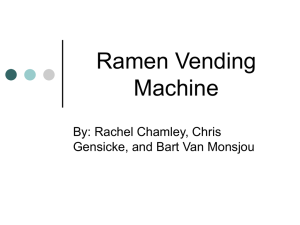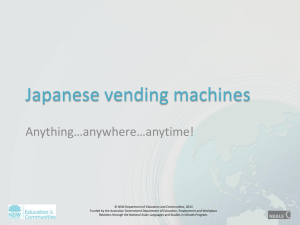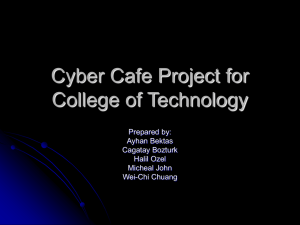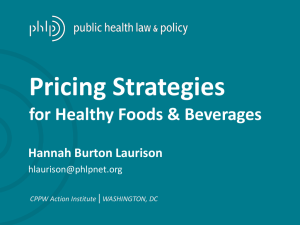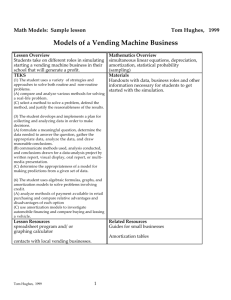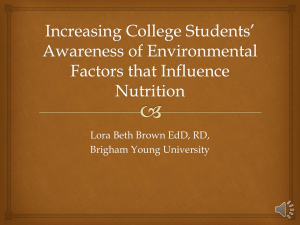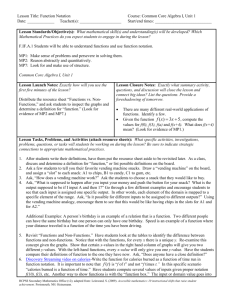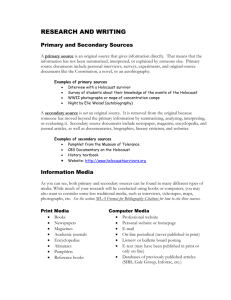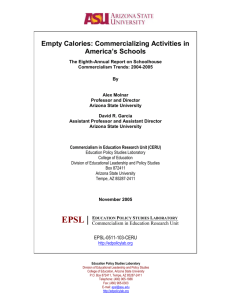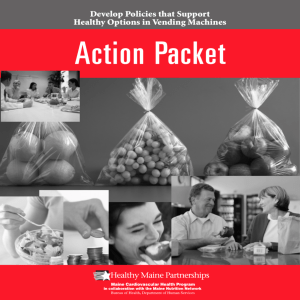Name: Guidelines: Read title of each passage and make a
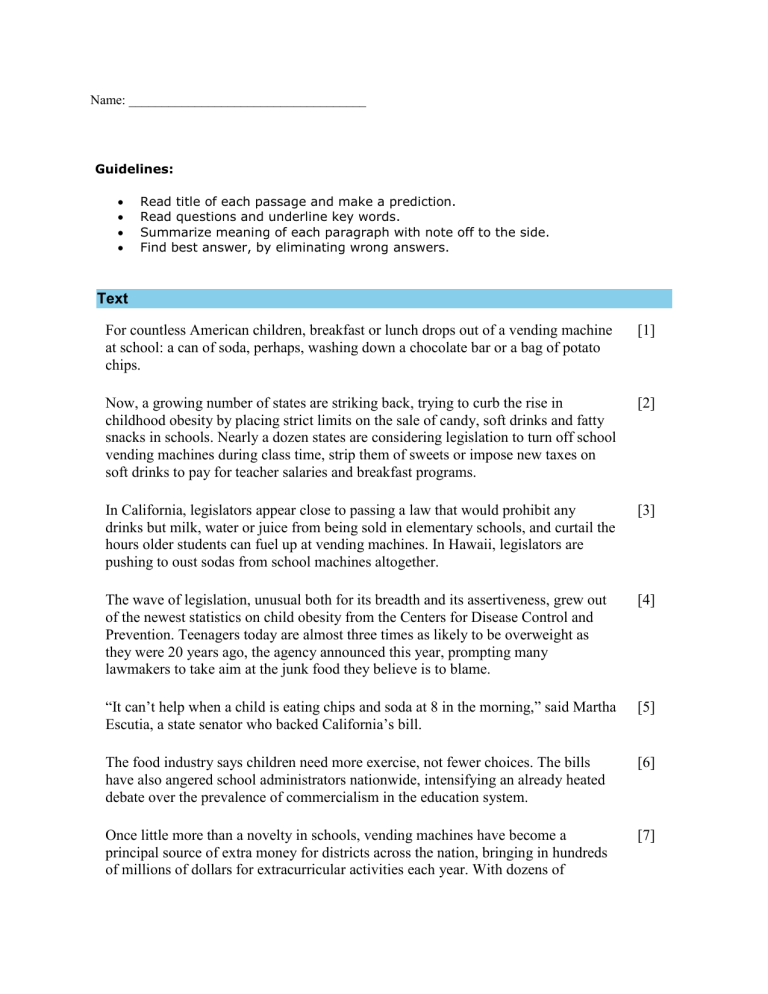
Name: ____________________________________
Guidelines:
Read title of each passage and make a prediction.
Read questions and underline key words.
Summarize meaning of each paragraph with note off to the side.
Find best answer, by eliminating wrong answers.
Text
For countless American children, breakfast or lunch drops out of a vending machine at school: a can of soda, perhaps, washing down a chocolate bar or a bag of potato chips.
[1]
Now, a growing number of states are striking back, trying to curb the rise in childhood obesity by placing strict limits on the sale of candy, soft drinks and fatty snacks in schools. Nearly a dozen states are considering legislation to turn off school vending machines during class time, strip them of sweets or impose new taxes on soft drinks to pay for teacher salaries and breakfast programs.
[2]
In California, legislators appear close to passing a law that would prohibit any drinks but milk, water or juice from being sold in elementary schools, and curtail the hours older students can fuel up at vending machines. In Hawaii, legislators are pushing to oust sodas from school machines altogether.
[3]
The wave of legislation, unusual both for its breadth and its assertiveness, grew out of the newest statistics on child obesity from the Centers for Disease Control and
Prevention. Teenagers today are almost three times as likely to be overweight as they were 20 years ago, the agency announced this year, prompting many lawmakers to take aim at the junk food they believe is to blame.
[4]
“It can’t help when a child is eating chips and soda at 8 in the morning,” said Martha
Escutia, a state senator who backed California’s bill.
[5]
[6] The food industry says children need more exercise, not fewer choices. The bills have also angered school administrators nationwide, intensifying an already heated debate over the prevalence of commercialism in the education system.
Once little more than a novelty in schools, vending machines have become a principal source of extra money for districts across the nation, bringing in hundreds of millions of dollars for extracurricular activities each year. With dozens of
[7]
machines lining their hallways, some schools annually earn $50,000 or more in commissions, then use the money for marching bands, computer centers and field trips that might otherwise fall by the wayside.
To keep such programs going, schools are emerging as the staunchest opponents of the proposed restrictions, invoking the same principles of local control that the states themselves use to fight federal standards for academic testing. In many cases, the resistance from schools has been vociferous
1
enough to water down or defeat measures, or at least stall them until the next legislative session rolls around.
[8]
“Let the parents, the students and the school community sit down and decide how to handle this,” said Robert E. Meeks, legislative director for the Minnesota School
Boards Association, which has organized against legislation to curtail soda sales.
Mr. Meeks added that Minnesota schools earn roughly $40 million a year from vending machines. “The states only seem to be interested in local control when it suits them,” he said.
[9]
[10] Many lawmakers say they find it odd that educators are their biggest foes, considering that the schools are supposed to look after the welfare of their students.
Half the students in some Texas and California districts are overweight, officials say.
“I can understand why school districts go in search of extra resources,” said Jaime
L. Capelo Jr., a state representative in Texas who introduced a measure to pare down the amount of junk food in schools. “But it’s shameful when they obtain additional resources through contracts with soda companies with little or no regard to the health of their students.”
[11]
[12]
Even some students express concern over the abundance of snack foods in their schools. Nell S. Geiser, a 17-year-old senior at New Vista High School in Boulder,
Colo., says the vending machines in the building never shut down. At 7:30 a.m., outside classrooms with corporate symbols like I.B.M. painted on the walls, she says her fellow students gather in front of the humming machines, comparing schedules on daily planners with logos of the WB network, courtesy of a local television station.
[13]
“Plenty of kids make their breakfast from a Mountain Dew and a bag of Doritos,” said Nell, who organizes fellow students to oppose soda contracts in schools.
“You’re brought up thinking it’s all right to be constantly bombarded with ads and junk food because they’re in your school.”
[14]
Educators, in turn, say that it is the lawmakers who are hypocritical, because as tax [15]
revenues sag in tandem with the economy, state legislatures are cutting school budgets, leaving districts with few choices but to search for substitute funds.
“Maybe it’s not the best way of making money,” said Paul D. Houston, executive director of the American Association of School Administrators. “But who is responsible for providing funding for schools? The very people who are now saying that we can’t engage in creative ways of raising money.”
[16]
Though they are often sympathetic to the economic woes of school districts, many lawmakers argue that encouraging children to indulge at an early age is ultimately fiscally irresponsible. As students become heavier and their health deteriorates, more serious ailments like diabetes can arise, leading to higher health care costs over time.…
[17]
The Department of Agriculture tried to ban soda and candy sales in schools more than two decades ago, but was thwarted by a federal appeals court in 1983. Now, federal regulations simply require schools to turn off soda and candy machines in the cafeteria during meal times. Those that sit outside in the hallways can stay on all day.
[18]
Several states go further. New York, which, like a handful of other states, is considering ways to increase exercise in schools, already prohibits food of “minimal nutritional value” from being sold until after lunch. New Jersey and Maryland have similar policies. But lawmakers say that such rules often make little difference.
[19]
“They’re totally ignored,” said Paul G. Pinsky, a state senator in Maryland and former high school teacher who introduced a bill this year to switch off vending machines during the school day. “After the sugar high wore off and they were finished bouncing off the walls, my students’ heads would fall on the desk,” he said.
“It made it really difficult to teach.”
[20]
Part of the problem, legislators say, is that the agreements between schools and soda companies sometimes deter principals from following state policy, especially since how much schools make is often tied to how much they sell.
[21]
One contract between the Pepsi-Cola Company and the Montgomery Blair High
School in Silver Spring, Md., stated that “if the Board of Education actively enforces the policy in which vending machines are turned off during the school day,” the school will not get its guaranteed commission. But the company is now taking a more conciliatory stand. Officials of Pepsi, a unit of PepsiCo, say they have redrawn the contract and others like it over the last year, so that they reflect what the company calls the “spirit and the letter” of state policies.
[22]
In other states, legislators question whether schools have disregarded state guidelines simply by allowing soda machines on campus. In recent years, North
Carolina schools have signed vending contracts with soft drink companies, even though the state’s official policy allows only sales that “contribute to the nutritional well-being of the child and aid in establishing good food habits.”
“It’s a bit of a conflict, isn’t it?” said Ellie G. Kinnaird, a state senator in North
Carolina who is seeking a moratorium on soft drink contracts in schools.
Six months ago, the Coca-Cola Company said that it would scale back on binding contracts with schools. But the new guidelines do not pertain to existing contracts, and may not affect future ones either.
[23]
[24]
[25]
On average, Americans drink nearly 60 gallons of soda each year, almost 8 gallons more than they did just 10 years ago. For many lawmakers, it is a given that the increase has worsened childhood obesity. To the food industry, assigning the blame to any one type of food is simplistic.
“There are no such things as good foods and bad foods,” said Chip Kunde, a legislative director for the Grocery Manufacturers of America, a food industry trade group. “There are just good diets and bad diets.”
[26]
[27]
Researchers vacillate 2 , pointing out that children are eating more of almost everything, not just sweets, while exercising less. In fact, only 29 percent of students attended daily physical education classes in 1999, compared with 42 percent in
1991, according to the Centers for Disease Control and Prevention, making it harder for them to burn off the extra calories they have put on.
[28]
1
vociferous — characterized by an insistent outcry
2
vacillate — change point of view
— Greg Winter excerpted from “States Try to Limit Sales of Junk Food in School Buildings”
The New York Times , September 9, 2001
Chart
1.
The text indicates that the move to ban vending machines in schools came about as a reaction to
1. parental pressure 3. legal opinions
2. health concerns 4. funding uncertainty
--------------
2.
According to the text, the proposed California law (paragraph 3) would prohibit the sale of
1.
junk food in elementary schools
2.
milk or juice in elementary schools
3.
soft drinks in high schools
4.
soft drinks in elementary schools
--------------
3.
According to the text, food industry representatives argue that schools are failing to provide students with adequate
1. counseling sessions 3. physical education
2. economic awareness 4. legislative protection
--------------
4.
According to paragraph 8, schools often view “junk food” legislation as conflicting with their right to
1. make decisions 3. enforce standards
2. teach nutrition 4. monitor student health
--------------
5.
According to the text, vending machines in schools send students a conflicting message about
1. educational opportunity 3. physical activity
2. user convenience 4. good nutrition
--------------
6.
The text implies that lawmakers feel the availability of “junk foods” in schools is
1. shortsighted 3. acceptable
2. essential 4. declining
--------------
7.
Paul G. Pinsky’s opinion (paragraph 20) is most probably cited because of his experience as a
1. food distributor 3. cafeteria worker
2. high school teacher 4. school board member
--------------
8.
According to the text, contracts between schools and soda companies may pressure schools to
1.
ignore existing legislation
2.
become creative fund-raisers
3.
reduce variety in cafeterias
4.
raise beverage prices
--------------
9.
The chart indicates that the availability of food choices in addition to foods which are part of the National School
Lunch Program generally increases with the
1.
number of lunches sold
2.
location of vending machines
3.
age of students
4.
length of school day
--------------
10.
According to the chart, more elementary schools than middle schools allow their students to
1. hold fund-raisers 3. visit snack bars
2. use vending machines 4. leave for lunch
--------------
